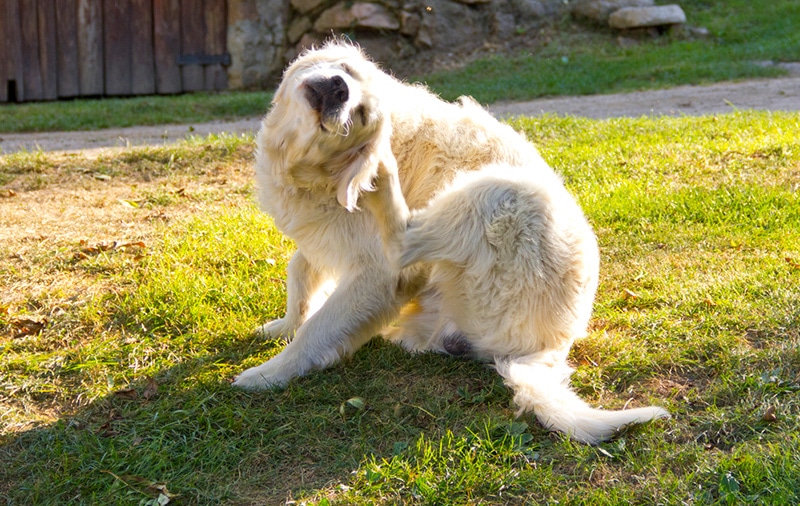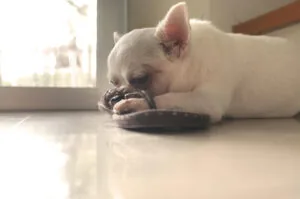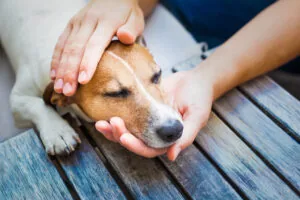Tips to Help Get Rid of Fleas

It’s still summer time and that means it is also flea season. Fleas, the most common parasite for dogs and cats, can be incredibly difficult to control. The best and most effective way is a multi-point attack. For those who have cat doors or dog doors, pets have a greater chance of exposure, so it especially important to consistently check pets for signs and symptoms of fleas. Below we share some knowledge about controlling fleas on your pets and throughout the house. Flea control is a multi-step process that requires several forms of control. It requires controlling fleas not only on your pet, but also in the house as well as any potential outdoor environments.
What Are Fleas?
A flea is a tiny parasite that feeds on the blood of their hosts. There are many species, but our pets usually play host to the cat flea (Ctenocephalides felis), whose dark brown or black body is usually one to three millimeters in length. Fleas are hearty and nimble. When searching for a host, they can jump 10,000 times in a row (the length of three football fields). Three pairs of legs make for excellent leaping capabilities (up to two feet), and a laterally flattened body allows for quick movement in a pet’s fur. Their life cycle ranges anywhere from 16 days to 21 months, depending on environmental conditions.
Thoroughly check your pets for fleas and ticks on a daily basis, particularly in warmer months, which you can do while grooming or playing with them. Ticks can be anywhere on your pet’s body, but prefer attaching themselves near the head, neck, ears, and paws. You may feel a tick “bump”, before you actually see the tick.
Signs your pet may have fleas:
- Small, red or brown colored debris known as “flea dirt” (which is the feces)
- Excessive scratching, licking or biting at skin
- Hair loss and/or dull haircoat
- Scabs or hot spots
- Allergic Dermatitis- red, inflamed skin
- Pale Gums
- Tapeworms
- Itchy Puppy
Fleas are Everywhere
When the humidity decreases, like it usually does in September, the flea population decreases as well. Your pet can pick up fleas pretty much anywhere. If you walk your dog in your neighborhood, your furry friend might end up picking up a hitch-hiker along the way. A house that is locked up for any length of time can make the temperature perfect for fleas to breed, creating a population explosion. Many people report of coming home to a crazy flea population explosion when they have been gone on summer vacation, often never noticing fleas before. The life cycle of fleas has four stages, with adults being the last stage. A startling statistic of a flea population is that adults only make up about 5%. Indeed, this makes it imperative to get a handle on the problem early. To this end, a multi-point treatment is usually the best way to curtail a problem.
Indoors
The most important step for indoor flea control is to thoroughly vacuum all rugs, furniture, and drapery on a regular basis. Fleas will lay eggs in areas such as rugs, grass, and furniture, and these eggs will develop and spread quickly. After vacuuming to remove eggs, use a carpet powder or spray that will prevent any future development of remaining eggs. Additionally, remember to wash all sheets, pet bedding, and other fabrics that your pet would be exposed to.
Outdoors
Fleas tend to inhabit organic debris in areas that are dark, moist, and in the shade. In order to rid your yard of fleas, concentrate on destroying any areas that would provide this type of habitat. Rake leaves and clean areas such as under porches, decks, dog houses, etc. Fleas, ticks, and other parasites that survive on animal hosts thrive in thick, uncut grass and large piles of leaves. The best way to eliminate them is to cut your grass at least once a week and keep lawn clippings and leaf piles to a minimum. If you own a dog, make it a point to clean up her outdoor waste every day. Parasites can live in piles of feces, which dogs sometimes unknowingly eat.
Pets
There are a variety of treatment options available for pets with fleas. These include sprays, monthly topicals, shampoos, dips and rinses, collars, flea combs, as well as injectable or oral products. These products are purported to kill any live fleas on your pet, however, often times you will still continue seeing fleas after any insecticide has been applied. Flea and tick preventatives can help avoid flea allergies, hot spots, skin infections, tapeworms, Lyme disease and flea and ticks in your home! Keeping your pets, family and home safe from fleas and ticks is best achieved through preventative measures and consistency. Be proactive and consult your veterinarian about the best methods of treatment for your pet when in doubt. Prevention is the best method of controlling fleas and ticks, but if your pets become infested with fleas or ticks, consider both your home and pets infested, and work swiftly to avoid a larger problem. If you are purchasing OTC flea and tick products and your pet(s) are still scratching and are miserable, your veterinarian will help you decide what would be best for your pet’s flea/tick preventative care.
Nothing Is 100%
It is important to note that there is no sure-fire, 100% way to eradicate fleas. A multi-point attack as outlined here is often the most effective way. Be cautious in relying on topical or oral flea control as the only means for controlling these nasty parasites. It can take up to three months for topicals or orals to be effective. Unfortunately, topical and oral flea control products do not offer an impenetrable barrier on your pet–fleas can still jump on your pet and might even bite or lay eggs. Remember, too, that the war against fleas does not end after your multi-front attack. Be sure to continue your pet’s oral or topical flea control per your product’s recommended period.
Fleas are a nuisance to pets and their people. If you end up with an outbreak, don’t feel bad or embarrassed. Everyone has a problem with fleas at some time. It does not make you a bad pet parent. If you see fleas on your pet or in your environment, take quick action before it worsens. You will be happy you did something to help your friend and your pet will be happy not to have vampire-like pests. As always, the best treatment for fleas is prevention. If you have pet doors, or a pet that is continually exposed to fleas, talk to your vet about prevention options. Carefully check your pet on a regular basis for signs of fleas, as well as take measures to ensure your pet’s outdoor space is not a conducive environment for fleas to inhabit.
Share This Post
Recent Posts
About Shallowford Animal Hospital
Shallowford Animal Hospital and The Pet Spa at Shallowford are dedicated to the exceptional, compassionate care your pet deserves. Pets hold a very special place in our families, and we treat yours like our own.



